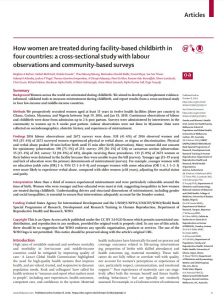
High rates of avoidable maternal and newborn mortality and morbidity in low-income and middle-income countries could be mitigated by improving quality of care. A Lancet Global Health Commission highlighted the need for high-quality health systems that improve health, and are valued, trusted, and responsive to dynamic population needs. Kruk and colleagues have called for health systems to “measure and report what matters most to people”, including user experiences, health outcomes, competent care, and confidence in the system. Maternal health indicators have historically focused on process and coverage outcomes related to life-saving interventions (eg, proportion of births with skilled attendance) and health outcomes (eg, maternal mortality).
These indicators do not fully reflect or correlate well with quality, nor account for women’s perceptions or experiences of care, particularly respect, communication, and emotional support. Poor experiences of maternity care can negatively affect both the woman herself and future health seeking behaviors but are typically not routinely assessed. For example, in a Cochrane review of continuous support for women during childbirth, only 11 (41%) of 27 trials reported women’s experiences, a primary review outcome.
Evidence suggests that women across the world experience mistreatment during childbirth, including physical abuse, verbal abuse, discrimination, non-consented procedures, and non-supportive care. Bowser and Hill’s landscape analysis brought this issue to global attention and our mixed-methods systematic review developed a typology of what constitutes mistreatment. The WHO intrapartum care guideline recommends respectful maternity care for all women, which is care that maintains “dignity, privacy, and confidentiality, ensures freedom from harm and mistreatment, and enables informed choice and continuous support during labour and childbirth.”
Manifestations and structural drivers of mistreatment are now well documented, but debate remains about measurement approaches, including the type (observation, woman-reported) and timing (exit interviews, community-based interviews) of measurement. For example, across 15 studies in seven low income and middle-income countries,18–32 location, timing, and populations varied substantially: facility-based exit interviews, facility-based interviews during postnatal immunization, and community-based interviews with women from 3 to 5 years post partum. The use of different populations, sampling, tools, and data collection methods might influence the risk of bias (selection, social desirability, information, recall) and render cross-study and cross-context comparisons challenging. Accurate measurement is essential to improve accountability, design interventions, and measure impact over time.
In 2013, a technical consultation recommended that WHO initiate research to develop and validate tools to measure the mistreatment of women during childbirth. The aim of the present study was to use a systematic, evidence-informed approach to develop tools to provide comparable data on the burden of mistreatment across contexts. The formative phase consisted of systematic reviews and primary qualitative research in Nigeria, Ghana, Guinea, and Myanmar. Formative research and a review of existing tools informed the measurement phase, which used continuous observations of women during labour and childbirth, and community-based surveys with post-partum women to measure the prevalence of mistreatment in Nigeria, Ghana, Guinea, and Myanmar. We report the prevalence of mistreatment during childbirth based on continuous labour observations and a community-based survey with women.